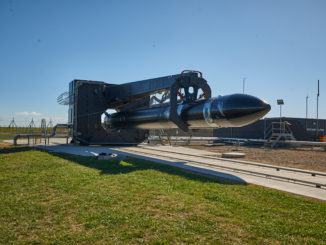
Another satellite for China’s Beidou navigation network rocketed into orbit Monday on top of a Long March 3B launcher.
Riding inside the Long March 3B’s nose cone, the new Beidou navigation satellite lifted off at 1809 GMT (2:09 p.m. EDT) Monday from the Xichang space center in southwestern China’s Sichuan province, according to the China Academy of Launch Vehicle Technology.
The launch occurred at 2:09 a.m. Beijing time Tuesday.
Liquid-fueled engines on the Long March 3B’s core stage and four strap-on boosters steered the rocket toward the east from Xichang. The boosters and core stage shut down and jettisoned less than two-and-a-half minutes after liftoff, and firings by the Long March 3B’s second and third stages finished the task of placing the Beidou navigation payload in orbit.
U.S. military tracking data showed the Beidou satellite orbiting Earth with a perigee, or low point, of about 120 miles (194 kilometers), and an apogee, or high point, of 22,256 miles (35,818 kilometers). The launcher deployed the Beidou spacecraft in an orbit inclined 28.6 degrees to the equator.
Monday’s missions was China’s ninth successful orbital launch of the year. Two more satellite launch attempts from China, both using new commercially-developed rockets, failed to achieve orbit earlier this year.
The Beidou satellite will use on-board propulsion to raise its perigee altitude to nearly 22,300 miles in the coming weeks. The craft will also maneuver into a higher-inclination orbit that allows it to move between 55 degrees north and south latitude during each 24-hour loop around the planet, a geosynchronous perch that matches the speed of Earth’s rotation.
China’s Beidou fleet is analogous to the U.S. military’s Global Positioning System network, and the Russian Glonass and European Galileo navigation systems. The Beidou program will give China an independent source of positioning and timing services for military and civilian users.
The Beidou network includes satellites positioned in three different types of orbits. Most of the Beidou satellites are in Earth orbit more than 13,000 miles above the planet, similar to the orbits used by GPS, Glonass and Galileo satellites. But unlike the other global navigation systems, the fully-operational Beidou network will include eight spacecraft in geosynchronous orbit, with five over the equator and three others in inclined orbits.
The satellite launched Monday is going into one of the inclined geosynchronous orbit slots. It’s the 46th Beidou navigation satellite launched since 2000 — a tally that includes no-longer operating Beidou test models — and the third Beidou spacecraft to launch this year.
The Beidou system started providing navigation service over the Asia-Pacific region in 2012, and China says the network will be ready for global coverage in 2020.
In order to achieve that schedule, Chinese officials say 10 Beidou satellites are planned for launch this year, China’s state-run Xinhua news agency reported.
Email the author.
Follow Stephen Clark on Twitter: @StephenClark1.



